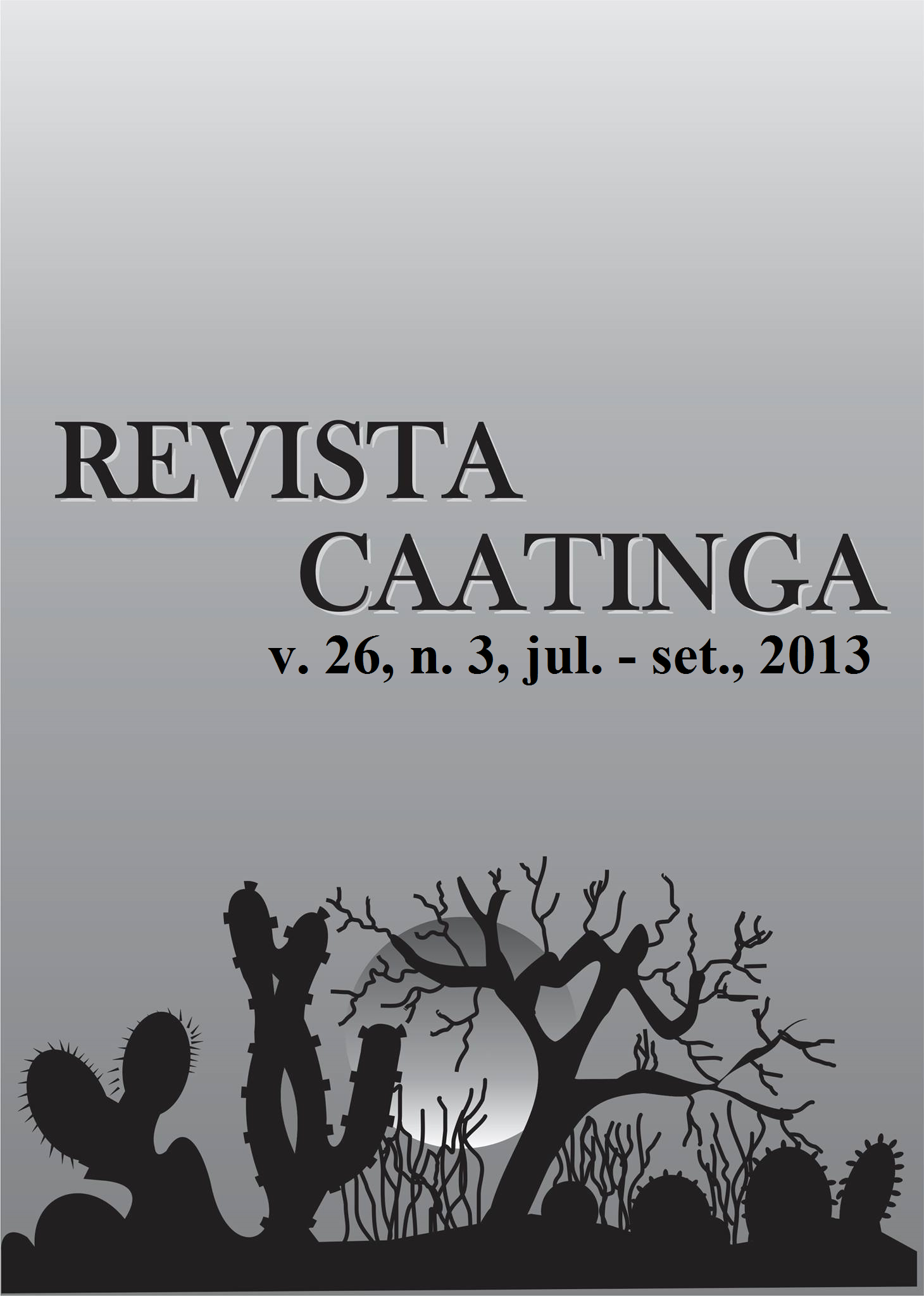CALLUS INDUCTION FROM FLORAL EXPLANTS OF CUPUASSU
Keywords:
micropropagation, explants, Theobroma grandiflorumAbstract
There are few studies related to the in vitro cultivation of plants from theTheobroma genus and no effective micropropagation protocols for T.grandiflorum. The aim of this study was to evaluate the calli formation in cupuassu floral explants, targeting their organogenic or embryogenicdevelopment. Experiments were conducted in the Plant Tissue Culture Laboratory of EMBRAPA, Porto Velho, Rondônia, Brazil. Floral parts from unopened immature flower buds taken from seedless cupuassu trees were sterilized and employed as a source of explants. These explants were cultivated in Petri dishes in an induction medium consisting of MS salts and vitamins, supplemented with glycine(3 mg.L-1), lysine (0,4 mg.L-1), leucine (0,4 mg.L-1), arginine (0,4 mg.L-1), tryptophan (0,2 mg.L-1), 2,4-D (1 mg.L-1), kinetin (0,25 mg.L-1), coconut water (50 ml.L-1), sucrose (40 g.L-1), Gelrite (2,2 g.L-1) and pH adjusted to 5,8. Cultures were maintained in the dark for 3 weeks at 27°C and then subcultured for six weeks in medium without growth regulators supplemented with glycine (1 mg.L-1), lysine (0,2 mg.L-1), leucine (0,2 mg.L-1), arginine (0,2 mg.L-1), tryptophan (0,1 mg.L-1), coconut water (100 ml.L-1), sucrose (40 g.L-1), Gelrite (2,2 g.L-1) and pH 5,8. We used a completely randomized design with 10 replications of 5 explants per plate and four different explant sources: staminode, petal, ligule and ovary. As a result, we obtained a highercalli formation in theinduction medium when ovaries were used as source of explants.However, there was no development of somatic embryosor organogenic response in medium without growth regulators and further studies are being conducted.Downloads
References
FERREIRA, M. G. R. et al. Desenvolvimento de calos em explantes de cupuaçuzeiro (Theobroma grandiflorum) em função da concentração de auxinas e do meio líquido. Revista Brasileira de Fruticultura, Jaboticabal, v. 23, n. 3, dez. 2001. Available from:<http://www.scielo.br/scielo.php?script=sci_arttext&pid=S010029452001000300004&lng=pt&nrm=iso>. Accessed: Sep 05, 2011. doi:10.1590/S0100-29452001000300004.
FERREIRA, M. G. R. et al. Indução de embriogênese somática em cupuaçu (Theobroma grandiflorum Schum.). Revista Brasileira de Fruticultura, Jaboticabal, v. 27, n. 3, dez. 2005. Available from: <http://www.scielo.br/scielo.php?script=sci_arttext&pid=S010029452005000300038&lng=pt&nrm=iso>. Accessed: Sep 05, 2011. doi:10.1590/S0100-29452005000300038.
LEDO, A. da S. et al. Explantes de cupuaçuzeiro submetidos a diferentes condições de cultura in vitro. Revista Brasileira de Fruticultura, Jaboticabal, v. 24, n. 3, dez. 2002. Available from:<http://www.scielo.br/scielo.php?script=sci_arttext&pid=S0100-29452002000300005&lng=pt&nrm=iso>. Accessed: Sep 06, 2011. doi:10.1590/S0100-29452002000300005.
LOPEZ-BAEZ, O. et al. Embryogenèse somatique de cacaoyer Theobroma cacao L. à partir de pièces florales. Sciences de la vie, Paris, n. 316, p. 579-584, 1993.
MEDEIROS, C.P.C. de. Indução in vitro de respostas morfogenéticas em explantes nodais de cajazeira (Spondias mombin L.). 1999. 79f. Dissertation (Master in Plant Science) Universidade Federal do Ceará.
MERKLE, S. A. et al. Morphogenic aspects of somatic embryogenesis in plants. In: THORPE, T. A. In vitro embryogenesis in plants. Dordrecht: Kluwer Academic Publishers, 1995. p. 155-203.
MURASHIGE, T., SKOOG, F. A. A revised medium for rapid growth and bioassays with tissue cultures. Physiologia Plantarum, Copenhagen, v. 15, p. 473-497, 1962.
PEREIRA, J. E. S. et al. Identificação e controle com antibióticos de bactérias endofíticas contaminantes em explantes de batata micropropagados. Pesquisa Agropecuária Brasileira, Brasília, v. 38, n. 7, jul. 2003. Available from: <http://www.scielo.br/scielo.php?script=sci_arttext&pid=S0100204X2003000700006&lng=pt&nrm=iso>. Accessed: Sep 09, 2011. doi:10.1590/S0100-204X2003000700005.
PIERIK, R. L. M. Vegetative propagation. In: PIERIK, R.L.M. 1990. In vitro culture of higher plants. [S.l.]: International Association for Plant Tissue Culture, 1990. p.183-230.
RODRIGUES, E. F. Desenvolvimento do eixo embrionário in vitro e calogênese de cupuaçu (Theobroma grandiflorum (Willd. ex Spreng.) Schum.) e estabelecimento do ápice caulinar de bacuri (Platonia insignis Martius). 2000, 70 f. Thesis (Doctor Science in Crop Production). Universidade Estadual Paulista.
RODRIGUES, F. R.; ALMEIDA, W. A. B. Calogênese em Cissus sicyoides L. a partir de segmentos foliares visando a produção de metabólitos in vitro. Revista Brasileira de Plantas Medicinais. Botucatu, v.12, n. 3, p. 333-340, 2010.
SILVA, M. B. et al. Indução de calos em espécies amazônicas do gênero Theobroma. Ciência & Agrotecnologia, Lavras, v. 30, n. 2, abr. 2006. Available from: <http://www.scielo.br/scielo.php?script=sci_arttext&pid=S141370542006000200010&lng=pt&nrm=iso>. Accessed: Sep 09, 2011. Doi:10.1590/S1413-70542006000200010.
STEIN, V. C.; PAIVA, R.; SILVA, L. C.; SILVA, D. P. C. da.; REZENDE, R. K. S.; OLIVEIRA, L. M. de. Calogênese em ovários de Inga vera Willd. subsp. affinis (DC.) T.D. Penn. Revista Brasileira de Biociências, Porto Alegre, v. 5, supl. 2, p. 303-305, jul. 2007.
VELHO, C. C. et al. Cupuassu: a new beverage crop for Brazil. In: JANICK, J.; SIMON, J. E. Advances in new crops: proceedings of the First International Symposium New Crops: research, development, economics. Portland: Timber Press, 1990. p. 372-375.
VENTURIERI, G. A.; VENTURIERI, G. C.. Calogênese do híbrido Theobroma grandiflorum x T. obovatum (Sterculiaceae). Acta Amazônica, Manaus, v. 34, n. 4, Dec. 2004. Available from:<http://www.scielo.br/scielo.php?script=sci_arttext&pid=S004459672004000400004&lng=en&nrm=iso>. Accessed: Sep 09, 2011. doi:10.1590/S0044-59672004000400004.
ZIMMERMAN, J. L. Somatic embryogenesis: a model for early development in higher plants. Plant Cell, Rockville, v. 5, n. 10, p. 1411- 1423, Oct. 1993. Available from: <http://www.plantcell.org/content/5/10.toc>. Accessed: Sep. 09, 2011. doi: 10.1105/tpc.5.10.1411.
Downloads
Published
Issue
Section
License
Os Autores que publicam na Revista Caatinga concordam com os seguintes termos:
a) Os Autores mantêm os direitos autorais e concedem à revista o direito de primeira publicação, com o trabalho simultaneamente licenciado sob a Licença Creative Commons do tipo atribuição CC-BY, para todo o conteúdo do periódico, exceto onde estiver identificado, que permite o compartilhamento do trabalho com reconhecimento da autoria e publicação inicial nesta revista, sem fins comerciais.
b) Os Autores têm autorização para distribuição não-exclusiva da versão do trabalho publicada nesta revista (ex.: publicar em repositório institucional ou como capítulo de livro), com reconhecimento de autoria e publicação inicial nesta revista.
c) Os Autores têm permissão e são estimulados a publicar e distribuir seu trabalho online (ex.: em repositórios institucionais ou na sua página pessoal) a qualquer ponto antes ou durante o processo editorial, já que isso pode gerar alterações produtivas, bem como aumentar o impacto e a citação do trabalho publicado (Veja O Efeito do Acesso Livre).







